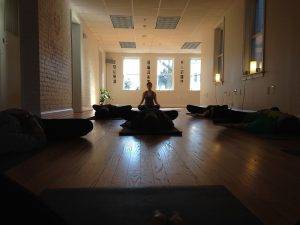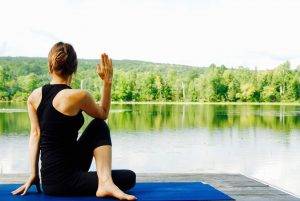
An Overview of Patanjali’s Eight Limbs of Yoga
January 29, 2018Active in the Community – Mind Body Award 2016
June 27, 2017Republished with permission from The Yoga Lunchbox, NZ’s most popular online yoga magazine
by Kara-Leah Grant
 This is an interesting question – how can I possibly know what meditation might suit you, especially when I don’t know ‘you’ at all?
This is an interesting question – how can I possibly know what meditation might suit you, especially when I don’t know ‘you’ at all?
There is therefore no definitive answer I can give you to this question. However, what I can do is take you through a process which can help you determine which type of meditation might be best for you.
In essence, I ask you questions, and you answer them.
Because who knows best, what’s best for you? You, that’s who.
To start, take a moment to consider what your criteria is for the “right” meditation?
- Is it a meditation that you can easily do, knocking it off in no time flat and ticking the “meditation” box for the day?
- Is it a meditation that looms so ominously in your mind that you do everything you can to possible avoid it, putting it off until another day which never seems to come?
- Or is it the middle way – a meditation conceivable for every day, yet challenging enough so that when you sit within it you edge out of your comfort zone and explore areas of discomfort?
 Contemplate these questions about your ideal meditation:
Contemplate these questions about your ideal meditation:
- How much time do you want to spend in meditation? (Or how much time each day can you carve out for meditation?)
- Where you want to meditate?
- How often you want to meditate?
- When you want to do it during your day?
Be realistic about the nature of your lifestyle, and choose a length, frequency and place that is doable, but also a slight stretch. Better to master a five minute meditation daily than to struggle with a sixty minute meditation weekly.
Once you’ve considered all this, make your meditation intention clear and set a sankalpa.
I intend to meditate daily for ten minutes whenever I can fit it in.
or
I intend to mediate as soon as I wake up every day for ten x ten breath counts.
Once you’ve set a clear sankalpa, examine the types of meditation that you know about.
Do some research on the internet, borrow a book from the library or attend a local meditation class.
Notice what types of meditation you’re drawn to, and what types you feel like you want to avoid. Often the ones we want to avoid hold the greatest treasure for us, but the ones we’re drawn to can help us establish habit and routine.
Select your meditation, commit to trying it out for a week, or two weeks, or even forty days if you want to turn it into a sadhana.
Then do it. But the work isn’t finishing yet…
 Pay attention to how your meditation practice makes you feel – in mind, body and spirit.
Pay attention to how your meditation practice makes you feel – in mind, body and spirit.
Gather this data, and respond as needed, adjusting length, frequency and type of meditation as required. This is the most important part of your practice – if you discover you feel more agitated after your practice, it may be that the type of meditation you’re doing is not right for you. If you find that you feel really floaty and ‘out-of-it’, it may be that more grounding meditation is required.
Any doubts, and the best course of action is to find and consult a knowledgable and experienced meditation teacher.
My personal top three meditations are breath counting and mantra meditation. Each of these gives the mind something specific to focus on, and helps to still the thoughts down.
- Breath counting is the simplest meditation. While seated in easy cross-legged, I count my breaths all the way up to ten, and then back down again. Sometimes I do this for a set time (using a timer in meditation is crucial!). Or sometimes I set a number of 10s to do – like 10. Eyes can be open or closed.
- Another meditation I like to do while on the bus is So Hum. As I inhale, a nice deep yogic inhale, I silently repeat So for the entire length of the inhale. As I exhale, I silently repeat Hum for the entire length of the exhale. As well, when I inhale, I’m aware of drawing the entire world into my being, and as I exhale, I’m aware of exhaling any small sense of self, or the ego identity. Eyes are open for this one, ad I generally softly focus on something directly ahead in my field of vision.
- The final meditation I often do is an Om meditation. Seated cross-legged with a timer set for 10 or 20 minutes, I focus on inhaling through my navel and up my spine while silently chanting Om. As I exhale I breath out my forehead centre while silently chanting Om. Over, and over, and over. This one is likely my favourite, as I do it four or five times a week. It really helps me to see clearly, to get my ego mind out of the way and perceive what is true – beyond the filters of maya that cloud our reality. In this meditation, the eyes are closed and focused softly upward on the inside of the eyebrow centre.
Hopefully this is enough information to make you feel comfortable about charting a course into the waters of meditation. It is the most rewarding journey you will ever take.
Happy meditating!
- How Understanding the Kleshas and Gunas Helps Your Asana Practice - September 19, 2017
- How to Choose the Right Meditation Technique for You - January 26, 2018
- An Overview of Patanjali’s Eight Limbs of Yoga - January 29, 2018






